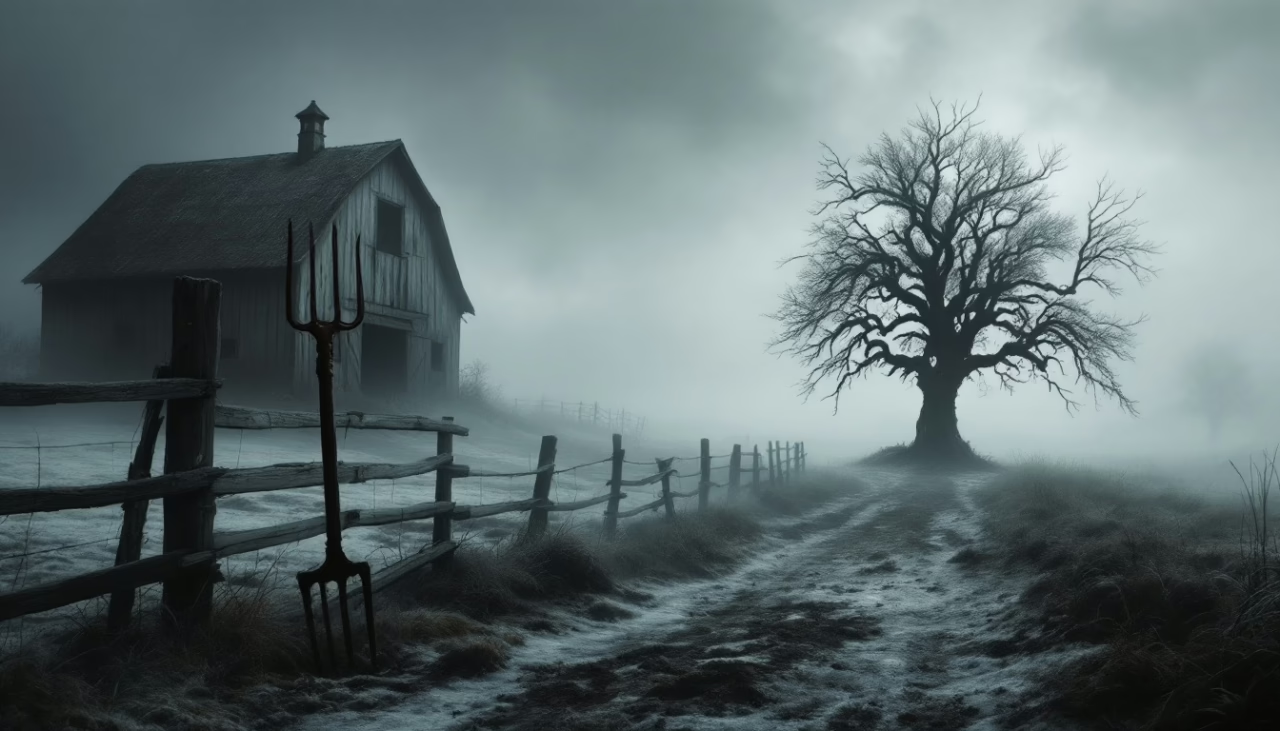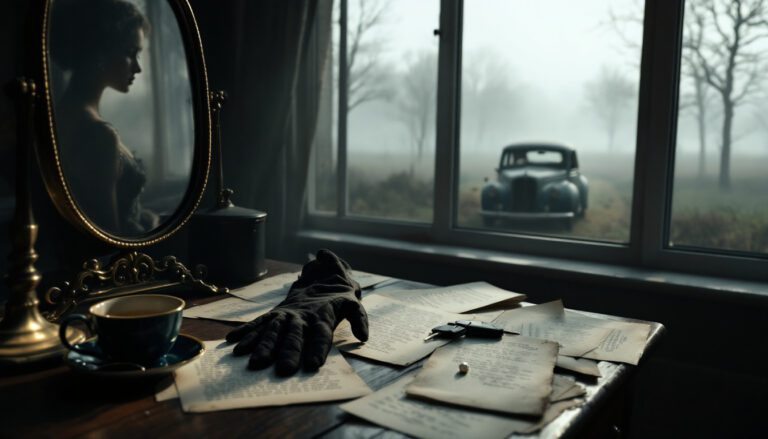Hinterkaifeck Murders: Unsolved 1922 Mystery

The Hinterkaifeck murders present a perplexing tableau of violence and mystery. On a remote Bavarian farm, six lives were extinguished in a brutal act that defies explanation.
Eerie occurrences preceded the crime, hinting at an unseen menace.
Following the tragedy, an unsettling presence lingered, as the killer seemingly inhabited the very space where the horror unfolded.
This case continues to evoke intrigue and speculation, prompting deeper questions about the nature of evil and unresolved histories.
Summary & Key Takeaways
Hide- The Hinterkaifeck murders occurred in 1922, resulting in the brutal deaths of six family members on a remote Bavarian farm.
- The attack exhibited premeditation, with victims lured to the barn and killed using a mattock.
- Unsettling signs, such as footsteps in the snow and missing keys, foreshadowed the horrific event, heightening the atmosphere of dread.
- Investigative flaws, including a four-day delay and poor evidence collection, hindered solving the case, leading to enduring speculation.
- The case remains a cultural phenomenon, inspiring books, documentaries, and amateur sleuths intrigued by the unresolved mystery.
A Quiet Farm Turned Crime Scene: The Night of March 31, 1922

On the night of March 31, 1922, the peaceful existence of the Gruber family was shattered as a brutal attack unfolded, transforming their rural home into a chilling crime scene.
In the days leading up to the incident, life at Hinterkaifeck had been marked by isolation and unease, hinting at the turbulence that would soon erupt.
This juxtaposition of ordinary life against the backdrop of horrific violence raises questions about the events that transpired and the motivations behind them.
The Gruber Family: Life Before the Horror
The Gruber family, comprising six members, inhabited the isolated Hinterkaifeck farm, where their daily routines painted a portrait of pastoral tranquility.
This seemingly serene existence, marked by agricultural labor and familial bonds, starkly contrasts with the horrific events that would unfold on the fateful night of March 31, 1922.
Understanding their lives prior to the tragedy is essential for grasping the profound impact of the murders that shattered this remote community.
Meet the Victims: Six Lives on a Remote Farm
Amidst the serene landscape of rural Bavaria, six lives intertwined within the Gruber family, each person contributing to the quiet rhythm of farm life.
Andreas, the patriarch, embodied resilience; his wife, Cäcilia, nurtured warmth; their daughter, Viktoria, balanced tradition and modernity.
The couple’s grandchildren, Josef and Maria, represented innocence, while the enigmatic servant, Maria Baumgartner, added complexity to their daily existence, unaware of impending tragedy.
Daily Routines: A Snapshot of Hinterkaifeck
While the sun rose steadily over the Hinterkaifeck farm, the daily routines of the Gruber family unfolded with a familiar cadence, reflecting both the simplicity and the hidden complexities of rural life.
Each member engaged in time-honored tasks—tending livestock, tending fields, and communal meals—embodying a delicate balance between tradition and struggle, a stark contrast to the impending tragedy that would shatter their existence.
The Brutal Attack: How the Murders Unfolded
On the fateful night of March 31, 1922, the Gruber family unknowingly walked into a meticulously orchestrated trap, their final steps leading them to the barn where their fate would be sealed.
The killer, wielding a mattock with chilling precision, executed the attack with a brutality that suggested both premeditation and an intimate knowledge of the victims’ routines.
As the events unfolded, the tranquil facade of Hinterkaifeck was irrevocably shattered, transforming the farm into a gruesome crime scene that would haunt the community for decades.
Lured to the Barn: The Family’s Final Steps
As the last light of day faded over the Hinterkaifeck farm on March 31, 1922, an unsettling calm enveloped the property, masking the impending horror.
The family, perhaps lulled into complacency by the familiar surroundings, unknowingly moved towards the barn—an area that would soon become a scene of unimaginable violence.
Their final steps, innocent yet fateful, foreshadowed a night steeped in tragedy.
A Killer’s Precision: The Mattock Strikes
The night of March 31, 1922, descended upon Hinterkaifeck like a shroud, cloaking the farm in darkness and silence that belied the violence soon to erupt.
A deliberate assault unfolded, marked by chilling precision:
- The metallic glint of the mattock, a farmer’s tool turned weapon
- The muffled cries swallowed by the night
- Bloodstains on straw, remnants of a gruesome act
This was no ordinary crime.
Eerie Signs: Strange Events Before the Slaughter
In the weeks leading up to the tragic events at Hinterkaifeck, a series of unsettling occurrences began to unfold, raising alarm among the residents.
Footsteps were heard in the snow surrounding the isolated farm, casting eerie shadows that hinted at an unseen presence, while missing keys and odd artifacts were discovered, suggesting a breach of safety and normalcy.
These strange signs, often dismissed as mere coincidence, foreshadowed the impending horror that would engulf the family.
Footsteps and Shadows: Warnings Ignored
In the days leading up to the tragic events at Hinterkaifeck, unsettling occurrences began to manifest, suggesting a presence both ominous and uninvited.
Disturbing tracks in the snow, seemingly leading from the woods to the farm, hinted at an unknown visitor, while the maid’s haunting accounts of noises in the attic further fueled an atmosphere of dread.
These eerie signs, dismissed by the occupants, reveal a chilling narrative of ignored warnings that foreshadowed the impending slaughter.
Tracks in the Snow: A Visitor From the Woods
Although the snow blanketed the landscape surrounding Hinterkaifeck, it was the unsettling tracks that captured the attention of those familiar with the farm.
The footprints, leading from the woods, sparked unease among the residents.
- Unfamiliar patterns, deviating from human prints
- A chilling absence of animal tracks
- Eerie shadows flitting at dusk
Each detail whispered warnings, yet they went unheeded, foreshadowing the impending tragedy.
Noises in the Attic: The Maid’s Haunting Tale
What could have driven the maid to share her haunting tale of the strange occurrences within the attic?
Whispers of footsteps echoed through the night, shadows danced unnaturally, and the very air felt charged with unease.
Each unexplained event heightened her anxiety, yet her warnings were dismissed.
This eerie prelude, shrouded in dread, left an indelible mark, hinting at the impending tragedy that would unfold.
Missing Keys and Odd Finds: Unexplained Clues
In the lead-up to the Hinterkaifeck murders, peculiar occurrences began to surface, including the mysterious disappearance of keys essential for securing the property.
This unsettling breach in security coincided with a puzzling newspaper clipping found on the premises, hinting at broader implications of fear and vulnerability.
Such odd findings not only raised eyebrows but also suggested a foreboding atmosphere that surrounded the family before their tragic fate.
The Munich Newspaper: A Puzzle on the Property
How did a series of unsettling events culminate in one of Germany’s most infamous unsolved murders?
The Munich newspaper reported eerie occurrences surrounding the Hinterkaifeck property, leaving investigators baffled.
- Mysterious footprints leading from the woods to the farmhouse
- A missing set of keys, untraceable and unexplained
- Odd sounds emanating from the barn, unsettling the family for weeks
A Key Vanishes: Security Breached
Although the Hinterkaifeck farmhouse appeared outwardly unremarkable, a disturbing breach in security emerged when a set of keys mysteriously vanished, triggering a cascade of unsettling events.
This disappearance heightened tensions among the residents, leading to whispers of hidden threats. Odd findings, including unexplained footprints and strange noises, compounded the fear, suggesting that sinister forces may have been at play long before the tragic murders occurred.
The Killer’s Chilling Stay: Living Among the Dead
In the aftermath of the grisly murders at Hinterkaifeck, unsettling reports emerged of a presence lingering at the crime scene.
Neighbors noted the unsettling sight of smoke billowing from the chimney of the isolated farmhouse, suggesting an occupant remained despite the horrific events.
This eerie juxtaposition of domesticity amid death raises profound questions about the killer’s psychological state and their chilling ability to coexist with the aftermath of their own violence.
Days of Occupation: A Murderer at Home
In the unsettling aftermath of the Hinterkaifeck murders, the killer’s presence lingered hauntingly within the confines of the farm.
The daily routine of feeding the animals and consuming the household’s provisions painted a grim tableau, juxtaposing domestic life with the horrific reality of the crimes committed.
This chilling coexistence not only underscores the psychological complexity of the murderer but also raises profound questions about the nature of evil when it inhabits the mundane.
Feeding the Animals: A Farm Kept Running
The eerie silence that enveloped Hinterkaifeck after the murders belied the daily chores that continued to bind the farm’s routine.
Animals still needed care, and the killer likely maintained this facade.
- The rhythmic clanging of buckets at dawn
- Hens clucking in the shadows of the barn
- The scent of hay masking the horror within
Life, unsettlingly, went on amidst the tragedy.
Eating the Food: A Grim Domestic Scene
A haunting stillness lingered in the air as the killer roamed the dimly lit rooms of Hinterkaifeck, where remnants of domestic life provided a chilling backdrop to the unfolding horror.
The act of consuming the household’s food transformed mundane meals into macabre rituals, a grotesque blend of survival and malevolence, as the murderer unwittingly intertwined their existence with the departed, echoing their final moments in eerie silence.
Smoke From the Chimney: A Neighbor’s Observation
The persistent smoke rising from the chimney of the Hinterkaifeck farm presented a perplexing conundrum for neighbors, suggesting signs of life amidst the chilling aftermath of the murders.
This enigmatic detail raises critical questions about the killer’s possible motivations for remaining on the scene, as well as the psychological implications of living among the deceased.
Theories surrounding the delay in discovery and the implications of a smoldering fire invite a deeper examination of the events that unfolded in this rural tragedy.
Signs of Life: The Fire That Kept Burning
While the chilling events surrounding the Hinterkaifeck murders unfolded, an unsettling detail emerged: the fire continued to burn in the farmhouse’s hearth, suggesting the presence of life amid the growing silence of death.
- A persistent plume of smoke curling from the chimney.
- The warmth radiating from the hearth, defying the frigid air outside.
- Shadows flickering, hinting at an unseen occupant in the darkened abode.
Why Stay? Theories Behind the Delay
As the eerie silence enveloped the Hinterkaifeck farmhouse, questions arose regarding the motivations behind the killer’s extended presence at the scene of such brutality.
Theories suggest a chilling enjoyment of control, perhaps a desire to erase evidence while feigning normalcy.
Smoke billowing from the chimney indicated life amidst death, while neighbors observed unsettling anomalies, sparking speculation about the killer’s psychological state and intentions.
The Investigation: A Case Plagued by Questions
The investigation into the Hinterkaifeck murders was marked by a troubling delay, with four days passing before the gruesome discovery was made.
This lag not only complicated the collection of essential evidence but also spawned a myriad of suspects and theories, each more perplexing than the last.
As the inquiry unfolded, the sheer volume of questions surrounding the case began to overshadow the search for definitive answers.
Discovery Delayed: Four Days of Silence
The unsettling absence of the Gruber family from school and church activities raised immediate concern among neighbors, signaling a break from their established routines.
In response, a search party was organized, with Lorenz Schlittenbauer taking a pivotal role in attempting to uncover the mystery behind the family’s disappearance.
This initial response, however, only served to deepen the enigma surrounding the case, as the subsequent discovery of the tragic scene would reveal far more than mere absence.
Neighbors’ Alarm: School and Church Absences
What might have prompted the neighbors of Hinterkaifeck to raise alarms over the unusual absence of the Gruber family from school and church?
The close-knit community sensed disquiet, leading to unease:
- Children absent from lessons, disrupting their routine.
- The Gruber family’s absence at Sunday service, a local tradition.
- An unexplained stillness around the homestead, heightening suspicions.
Such factors ignited concern, foreshadowing a tragedy that would soon unfold.
The Search Party: Lorenz Schlittenbauer’s Role
Driven by mounting concern for the Gruber family, Lorenz Schlittenbauer took the initiative to organize a search party, rallying local farmers and neighbors to investigate the eerie silence surrounding the Hinterkaifeck homestead.
This collective effort, however, revealed a disturbing scene, as the party unearthed not only a haunting stillness but also questions that would linger, amplifying the mystery of the Gruber family’s disappearance.
Suspects and Theories: Who Could Have Done It?
As the investigation into the Hinterkaifeck murders unfolded, two prominent figures emerged as potential suspects, each shrouded in their own enigmatic narratives.
The neighbor, Schlittenbauer, raised eyebrows with his peculiar behavior and connections to the family, while the eerie possibility of Karl Gabriel’s return from the war loomed large, igniting speculation about motives rooted in jealousy and unresolved conflicts.
Together, these individuals represent the complex web of theories that continue to challenge the understanding of this haunting case.
The Neighbor’s Shadow: Schlittenbauer Examined
In the labyrinth of suspicion surrounding the Hinterkaifeck murders, the figure of Lorenz Schlittenbauer emerges as a pivotal yet enigmatic character.
His involvement raises critical questions that complicate the investigation:
- A neighbor with intimate knowledge of the victims’ routines.
- His curious behavior during the investigation, often appearing too enthusiastic.
- Unfounded accusations toward others, deflecting attention towards himself.
Schlittenbauer’s shadow looms large over this unsolved mystery.
A Ghost From the War: Karl Gabriel’s Return?
The shadow cast by Lorenz Schlittenbauer is only one aspect of the complex narrative surrounding the Hinterkaifeck murders, as the specter of Karl Gabriel adds another layer of intrigue.
Gabriel, presumed dead in World War I, allegedly returned, igniting speculation about his potential involvement. This notion, rife with ambiguity, raises questions about loyalty, madness, and the thin veil between life and death in the face of unresolved tragedy.
Why Hinterkaifeck Still Haunts Us Today
The Hinterkaifeck murders continue to resonate in contemporary society, embodying a century-long enigma that inspires both fear and fascination.
This unsolved case serves as a stark reminder of humanity’s vulnerability and the dark potential lurking within isolated communities.
Additionally, the lessons gleaned from the investigation illuminate the complexities of human behavior, underscoring the necessity for vigilance and understanding in the face of inexplicable violence.
A Century of Wonder: The Unsolved Legacy
The Hinterkaifeck murders, shrouded in mystery for over a century, continue to captivate the public imagination through various forms of pop culture, such as books, films, and podcasts that explore the enigmatic crime.
This enduring fascination has prompted countless amateur sleuths to initiate their own quests for truth, fostering a community that thrives on piecing together the chilling narrative.
As speculation flourishes, the unresolved nature of the case serves not only as a chilling reminder of human violence but also as a reflection of society’s unyielding desire for closure.
Pop Culture’s Grip: Books, Films, and Podcasts
While the chilling tale of the Hinterkaifeck murders has faded from the collective memory of many, it continues to permeate popular culture, revealing humanity’s enduring fascination with unsolved mysteries.
This intrigue manifests through various mediums, including:
- Bestselling books exploring the gruesome details
- Documentaries and films that dramatize the events
- Podcasts dissecting theories and inviting speculation
This cultural engagement keeps the haunting legacy alive.
Amateur Sleuths: The Hunt for Answers Continues
Interest in the Hinterkaifeck murders has sparked a surge of amateur sleuths enthusiastic to unravel the enigma of this infamous crime.
These modern investigators, armed with technology and historical curiosity, dissect archival evidence and local lore, seeking patterns overlooked by authorities.
Their relentless pursuit not only rekindles public interest but also illustrates humanity’s enduring quest for truth amidst the shadows of unresolved history.
Lessons From the Past: What the Case Teaches Us
The Hinterkaifeck murders serve as a stark reminder of the limitations inherent in early forensic investigations, where missteps can obscure the truth and hinder justice.
This notorious case also underscores the enduring fascination of unsolved mysteries, captivating public imagination and igniting speculation that transcends time.
Such elements create a haunting narrative that continues to resonate, inviting reflection on the intersection of human fallibility and the quest for understanding.
Forensic Flaws: Early Mistakes in the Probe
A critical examination of the Hinterkaifeck murders reveals significant forensic flaws that plagued the initial investigation, ultimately hindering the pursuit of justice.
These early mistakes not only obscured the truth but also established a precedent for negligence in criminal inquiries.
- Lack of preservation of the crime scene
- Inadequate collection of physical evidence
- Overreliance on eyewitness accounts
The Power of Mystery: Why We Can’t Forget
Haunting echoes of the Hinterkaifeck murders persist in collective memory, fueled by the case’s enduring mysteries and unsolved questions.
This enigmatic legacy captivates the imagination, inviting speculation and analysis. It serves as a reminder of humanity’s vulnerability and the shadows that lurk within.
In confronting the unknown, society grapples with fear and curiosity, revealing deeper truths about the human condition and its inherent complexities.
Wrapping Up
The Hinterkaifeck murders remain an unsettling enigma, embodying humanity’s enduring fascination with unresolved mysteries.
The chilling notion of a killer cohabiting with their victims, as seen in the infamous case of the “Black Dahlia,” where Elizabeth Short’s unsolved murder captivated the public, underscores the psychological complexities of such crimes.
The shadows of Hinterkaifeck linger not only due to the brutal acts committed but also because they challenge our understanding of safety, community, and the darkness that can dwell within.





